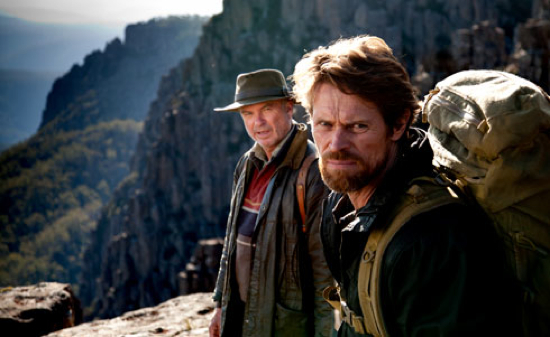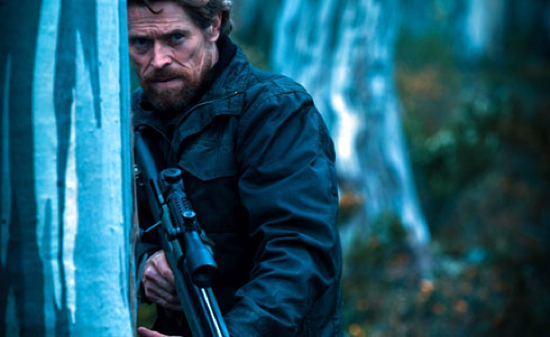Contracted by a shady biotech corporation known as Red Leaf, mercenary Martin David (Willem Dafoe) travels from Europe to Australia, to hunt what is thought to be the last remaining Tasmanian tiger. With only unverified sightings to work from and a small town mentality to overcome – of loggers struggling to find work with environmental activists at their back – tensions are high as Martin (referred to only as ‘M’ in Julia Leigh’s original novel) assumes the identity of a university researcher, and lodges with a family out in the forest.
He is treated as suspect by both sides, logger and ‘greenie’ alike, set up as very much ‘the outsider’ from the opening shots. He likes his orderliness. He is careful, taciturn and precise, recalling George Clooney in recent thriller The American (which itself recalls Antonioni, et al). We see Martin’s toiletries and razor lined up neatly along the hotel sink, while he fully submerges himself in the bath. "It must be nice, not to need anyone," observes his client from Red Leaf.
The dialogue is spare, at first, as we follow Martin into the forest. There he meets two children: the noisy, foul-mouthed Sass (Morgana Davies) and her quiet, insular brother Bike (Finn Woodlock). Their father is missing under suspicious circumstances; their mother, Lucy Armstrong (Frances O’Connor), sedated in bed. Lucy is cared for, occasionally, by Jack Mindy (Sam Neill), a local who has contact on both sides of the forest turf war. When Martin arrives, he sets up base while reluctantly bonding with the kids in between fortnight-long treks through the wilderness, where he stalks his elusive catch.
It’s not surprising that the latter provide the strongest scenes of Daniel Nettheim’s The Hunter, this being the Australian television director’s sole feature since his 2000 romantic comedy debut Angst. Much praise is due to cinematographer Robert Humphreys, whose visuals are rich, the colours slightly drained. A gritty sheen captures the hunt, with slow motion employed to good effect. The camera, trained on Dafoe in almost every shot, observes him master the forest by setting traps – some improvised by hand, others with mechanical aid.
We are left to work out the reason for, and purpose of, each of his actions. Nettheim controls the pacing remarkably, allowing his audience space to think in the dialogue-free hunt scenes. Why, for example, does Martin run his clothes through smoke after a night by the fire? Or why does he shoot, gut, and quarter a then-discarded marsupial? It is this side of Alice Addison’s script that disciples of a more savage Ray Mears, or enthusiasts of an outdoorsy Albert Camus, will find extremely appealing. It allows a certain respect for the audience to infer, to settle into the paranoid rhythm the film so confidently sets. And everything is answered eventually.
Occasionally coming into contact with local loggers who suspect Martin of siding with the greenies, an uneasy air of Deliverance breathes across the screen, particularly when shit is smeared across the windshield of his car, surprisingly legibly, to read: ‘Go home greenie scum’. We also learn that a second hunter, played by a now grown-up Drazic from Heartbreak High (Callan Mulvey), has been told to go with him, against our hero’s wishes. Dafoe contends with other Australian TV cast members – a few from the The Secret Life Of Us and the overrated Underbelly – as he endeavours to complete his sci-fi objective of harvesting the tiger for a unique toxin, to be possibly used for military purposes.

This is one of The Hunter‘s strengths. Rather than revealing things outright, it gives us clues. We’re shown a destroyed clamp trap, hear an anonymous gunshot in the wilderness and are told, through Bike’s paintings, that Lucy’s husband was also tracking the Tasmanian tiger, albeit for different reasons. However, the other side of the script lets it down slightly in the final stages, by attempting to throw an emotional punch with existential shadowboxing. Whereas there seems to be a certain respect for the intellect, The Hunter takes the emotions as a given, hoping that contrite and rote feelings will carry it through to the finish. At one point Martin is telephoned by his client, as he cuts sandwiches in the kitchen for a picnic with the children. He must break his promise to Sass and go back to work. They stand there watching him leave, trapped in melodramatic clichés, emotional white noise fizzing all around them.
Though it is not a glaring imbalance, the two incongruous levels this movie attempts to combine work against each other by the time credits roll. We are most intrigued during the quiet hunt scenes, when only cracking twigs under foot or a huffing snow breeze concern our ears on the soundtrack. Humans, with their meddling and their talking, just get in the way.
Admittedly, the subplot does bookend the film to provide us with ‘an emotional journey’. Martin learns that although he may not need people, people may need him. This is so oddly blended – on the one side with an intriguing and subtly directed narrative, and on the other with near-melodramatic platitude – that ultimately it feels like a missed opportunity, never really taking on the meditative tone it sets out with. But the first time Dafoe slowly rests his hand on the grey tree to steady a rifle shot, that might be worth seeing again.


